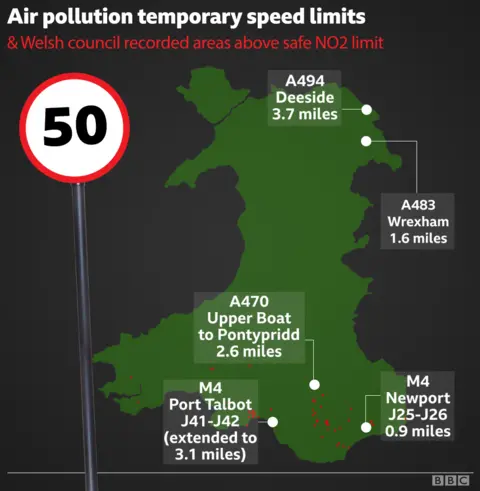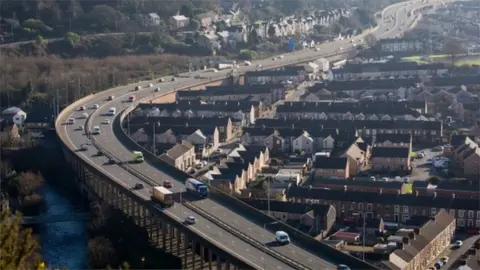Dangerous levels of roadside pollution in Wales 'overlooked'
 Getty Images
Getty ImagesMoves to tackle roadside pollution are overlooking large areas where there are potentially dangerous levels of nitrogen dioxide, an expert has warned.
Currently, seven areas in Wales - including Hafodyrynys, Caerphilly county - are being targeted by the Welsh Government based on EU measuring.
But Swansea University experts said people will keep dying from exposure to the gas if council data is ignored.
Latest figures from 2016 show 81 out of 916 places tested exceed safe limits.
"There is an urgent need to address these other sites," said Prof Paul Lewis.
"Many of the 1,000-plus people who die because of exposure to NO2 [nitrogen dioxide] live in these areas and if the problem's not addressed we're still going to have a high mortality rate in these areas," he said.

NO2 is linked to diesel engine emissions, and all areas with high levels in the council-collected data were in south east and south west Wales, with 24 in Rhondda Cynon Taff.
There were also 20 in Swansea, 11 in Newport, eight in Carmarthenshire and five in Caerphilly.
The Welsh Government is taking action against roadside pollution and announced £20m for its air quality strategy back in November.
"It sets out action we are taking on five sites on the Welsh Government-managed road network and in two Welsh local authority areas," a spokesman said.
"The actions are designed to achieve legal limits for NO2 within the shortest possible time and, most importantly, protect public health."
As part of this, speed limits were put in place on some roads.

But this relies only on data and predictions gathered by the Department for Environment, Food and Rural Affairs (Defra) under EU rules, said Prof Lewis, the director of the Centre for Health and Environmental Management, Research and Innovation.
He said it does not include data collected by councils by putting monitors on lampposts.
Prof Lewis said the solution was new legislation that brings all the air quality data gathered under one set of rules.
Plaid Cymru AM Dr Dai Lloyd, who chairs the assembly's clean air group, said the findings should be "a wake-up call".
"We should be looking at all the evidence," he said.
[But] we need to know exactly what we are tackling and that starts with accurate measurements."
Safe levels of NO2 are below 40ug/cm3 - with the two worst levels recorded by councils around Cymmer in Rhondda Cynon Taff, where readings of 67.9 and 64.6 were taken.
 Getty Images
Getty ImagesDerek Cummings, from Treorchy, has chronic obstructive pulmonary disease and said there were days when the smell of diesel could have an impact on his health.
"The hard part for me when I'm driving down the road to the Tonypandy bypass is to see a car in front of me belching out smoke," the British Lung Foundation volunteer said.
"I know it's going to make me ill. I have to turn the heating off so I don't suck in no more because that pollution's going to get in.
"It's going to cause my lungs to inflame and it'll take me days to get better. I'm going to be oxygen-deprived and in bed purely because of pollution that something can be done about."
Sian Reagan, the mother of a pupil at Cardiff's Ysgol Glan Morfa said fumes coming from cars concerned her.
She added: "We do try and walk to school ourselves as a family and it would be great if as many people who are able to could walk to school."
